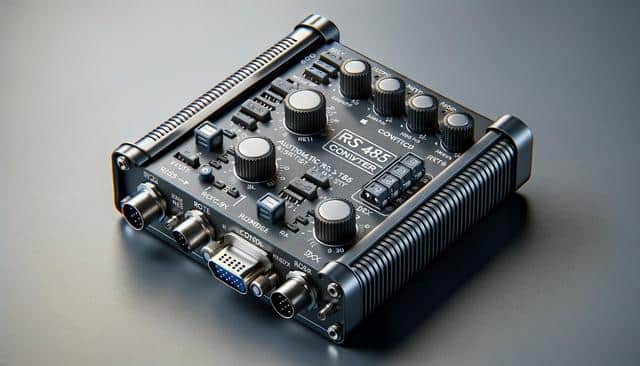Understanding RS232 and RS485 Communication Standards
Before diving into how RS232 to RS485 converters with automatic Rx/Tx control work, it’s important to understand the fundamental differences between RS232 and RS485 communication protocols. RS232 is a point-to-point communication standard typically used for short-distance data transfer between two devices. It uses single-ended signaling and supports one transmitter and one receiver. In contrast, RS485 is a multi-point communication standard designed for longer distances and more complex network topologies. It uses differential signaling and allows for multiple devices on the same bus, making it ideal for industrial and automation environments.
The challenge arises when devices using these two different standards need to communicate. RS232 and RS485 are not directly compatible, so a converter is necessary. A standard RS232 to RS485 converter typically includes circuitry that translates the voltage levels and signal types. However, converters with automatic Rx/Tx control offer a significant advantage by managing the data direction automatically, which is crucial in half-duplex RS485 communication.
The Role of Automatic Rx/Tx Control
One of the key complexities in RS485 communication is managing the direction of data flow. In a half-duplex system, a device cannot send and receive data simultaneously. Traditionally, this requires manual control of the transmit and receive lines, often through dedicated software commands or external signal lines. This can lead to timing issues or collisions if not managed properly.
Converters with automatic Rx/Tx control simplify this process significantly. These devices automatically detect data transmission on the RS232 side and switch the RS485 bus to transmit mode. Once the data has been sent, the converter seamlessly switches back to receive mode. This automatic switching eliminates the need for manual direction control and reduces the complexity of the communication setup. Benefits include:
- Reduced software overhead
- Faster development and deployment
- Improved reliability in timing-sensitive applications
- Simplified integration with legacy systems
Key Features of RS232 to RS485 Converters
RS232 to RS485 converters with automatic Rx/Tx control come with a variety of features that make them suitable for a wide range of applications. These features are designed to ensure compatibility, durability, and ease of use. Some of the common attributes include:
- Support for both 2-wire and 4-wire RS485 modes
- Built-in surge protection and optical isolation
- Wide operating voltage ranges
- Automatic baud rate detection
These converters are often designed with industrial use in mind, meaning they are built to withstand harsh environments, including extreme temperatures, humidity, and electrical interference. Moreover, their plug-and-play nature allows for quick setup without extensive configuration, making them a practical solution for both new installations and upgrades of existing systems.
Applications in Real-World Scenarios
The use of RS232 to RS485 converters with automatic Rx/Tx control spans a wide range of industries and applications. They are particularly valuable in industrial automation, building management systems, and energy monitoring, where reliable and efficient communication is critical. Some specific use cases include:
- Connecting legacy RS232-based PLCs to modern RS485 networks
- Integrating sensors and meters that use RS485 interfaces with older computer systems
- Enabling communication between SCADA systems and field devices
- Facilitating data collection in large-scale environmental monitoring setups
In each of these scenarios, the automatic Rx/Tx control functionality helps reduce the engineering effort required to establish communication, while also improving system reliability. These converters are frequently used in distributed systems where manual direction control would be impractical or prone to error.
Installation and Integration Considerations
When implementing RS232 to RS485 converters with automatic Rx/Tx switching, several factors should be considered to ensure optimal performance. Firstly, understanding the network topology is essential—knowing whether the RS485 side will use a 2-wire or 4-wire configuration will guide the proper setup. Additionally, grounding and termination resistors must be correctly applied to prevent signal reflections and data corruption.
Another consideration is the physical placement of the converter. Ideally, it should be installed close to the RS232 device to minimize signal degradation. The quality of the cabling also plays a vital role; twisted pair cables are typically recommended for RS485 lines to enhance noise immunity. During integration, it is important to verify baud rates, parity, stop bits, and other serial parameters to ensure compatibility between the connected devices.
Lastly, some converters offer diagnostic LEDs or software tools to assist with troubleshooting. These can be helpful during the installation phase, allowing technicians to identify problems such as wiring errors, incorrect settings, or communication timeouts.
Conclusion: Simplifying Serial Communication with Intelligent Controls
RS232 to RS485 converters with automatic Rx/Tx control present an efficient and reliable way to bridge communication between devices using different serial standards. By automatically managing data direction, these converters reduce the complexity of RS485 communication setups, making them particularly useful in environments where stability and ease of integration are essential. Whether used in industrial automation, data acquisition, or system retrofitting, these devices offer a streamlined solution that supports robust and scalable communication networks.




Leave a Reply